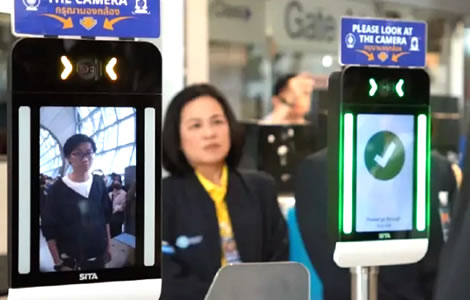Thailand’s main airports launch facial recognition tech, streamlining passenger flow as international arrivals soar 34% up to October. New systems allow travellers to bypass checkpoints, while airport expansion, including a third runway at Suvarnabhumi, ramps up.
Thailand has introduced biometric face recognition technology for passengers at its main airports. The move comes amid rising traffic and expansion plans for the industry. This includes the opening of a third runway at Suvarnabhumi Airport and a 34.82% rise in international passengers for the year up to the end of October. Nonetheless, although this week saw the return of British Airways to Bangkok, flights in and out of Thailand have not yet returned to pre-pandemic levels.

From Friday, departing passengers at Thailand’s main airports had access to biometric learning facilities on flights after check-in. In short, the new system uses facial recognition technology, allowing passengers to voluntarily scan their faces. After that, a token is created together with their passport information. In turn, they are then allowed unimpeded access to the post-departure area.
In short, they can pass through security or board their flights without being screened at checkpoints by officers.
This week, the Airports of Thailand (AOT) explained both the technology and the benefits of the new system. Chief Executive Officer Keerati Kijmanawat said it would improve the passenger experience. In addition, it would help speed up processes within the airport.
Airports of Thailand rolls out facial recognition to streamline passenger flow at main Thai airports
The innovation is part of a drive by the Airports of Thailand (AOT) and the Ministry of Transport to improve Thailand’s airport infrastructure. Clearly, this is part of the aviation hub vision outlined last year by former Prime Minister Srettha Thavisin.
The new technology is called the Automated Biometric Identification System (ABIS). It has gone into effect at six Airports of Thailand (AOT)-managed airports: Suvarnabhumi Airport, Don Mueang Airport, Chiang Mai Airport, Hat Yai Airport, Phuket International Airport, and Mae Fah Luang Airport in Chiang Rai.
Afterwards, the facility will be expanded to international departures from December 1. On Friday, airport personnel suggested that the registration system for the Automated Biometric Identification System (ABIS) took approximately 1-2 minutes.
Automated Biometric Identification System set for rollout across six major airports from December 1
Indeed, there are two ways to register. Firstly, after checking in at the check-in desk, passengers are advised to ask the airline agent to assist. Secondly, after a boarding pass is issued, the passenger may use kiosk points to scan their face or biometric data while inserting both their boarding card for scanning and either their passport or national identity card.
In tandem with the announcement on Friday, Mr. Keerati highlighted the growth of passenger numbers through Thai airports this year. In short, the overall figure is up some 19.22%, amounting to 119.29 million passengers.
Notably, the kingdom anticipates a rise of 26.31% in tourist arrivals this year. However, Mr. Keerati noted that the rise in passengers is being driven by international flights. For instance, international passengers have risen by 34.82% this year, from September 30 2023 to October 31 2024. This represents 72.67 million passengers carried both in and out. Meanwhile, domestic flight activity is only up 1.015%, with 46.62 million passengers.
In the meantime, the rise in traffic for the tourism high season will see flights up by 33.5% compared to last year. Similarly, domestic flights are primed for an 8.5% rise.
Significant rise in international and domestic passenger numbers driven by tourism high season growth
At this time, the number of flights being handled by Thai airports has not yet reached the level seen in 2019 or pre-pandemic. Nonetheless, the situation is improving.
For instance, this week, British Airways flew back to Thailand for the first time since the pandemic. The iconic airline will fly three flights a week from Gatwick, London to Suvarnabhumi Airport in Bangkok. Significantly, this will rise to five flights per week in February and March 2025.
Police warn travellers arriving at Bangkok’s airports of a fast-track immigration clearance scam offer
Airports move to drive traffic with self-service for outbound travellers from December 15th
Thailand faces an uphill struggle to become the aviation hub it once was before the pandemic era
On Wednesday last, Deputy Minister of Transport Monporn Charoensri underlined Thailand’s determination to boost its airport and aviation industry standards. The minister highlighted the opening of a third runway at Suvarnabhumi Airport. Certainly, this will increase the number of flights per hour from 68 to 94.
After that, in 2025, Thailand’s airports are projected to see a further 8.95% rise in passengers. In brief, this will include 78.61 million international passengers and 51.36 million domestic travellers.
Significantly, the top inbound routes were from China, Malaysia, India, Singapore and Hong Kong.
Join the Thai News forum, follow Thai Examiner on Facebook here
Receive all our stories as they come out on Telegram here
Follow Thai Examiner here
Further reading:
Thailand faces an uphill struggle to become the aviation hub it once was before the pandemic era
Thailand wants to see far more US and Canadian tourists as long-haul visitors spend twice as much
Passenger complaint turbulence as Thai Airways appears to plot sky-high Dreamliner expansion
Passengers to finally get refunds from high-flying Thai Airways still facing financial turbulence
Flying high at Thai Airways as numbers skyrocket as it flies tourists into the kingdom from Europe


















